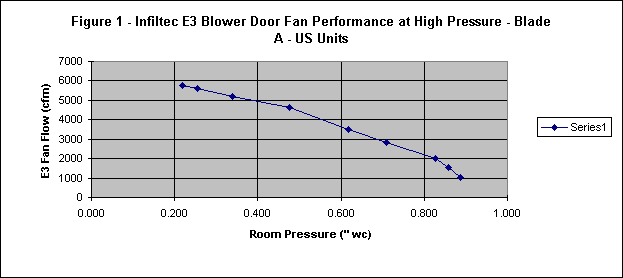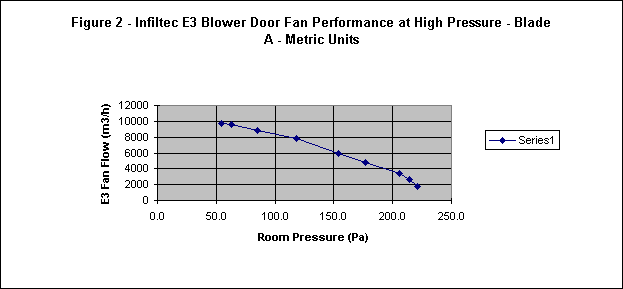RADON CONTROL | About Radon | Radon FAQ | Pictures | Drawings | Fans | Large Buildings | Radon Catalog |
AIR LEAKAGE | About Blower Doors | FAQ | Ducts | Fire | Large Buildings | Contractors | Blower Door Catalog |
OTHER INSTRUMENTS | Personal Seismometers | Infrasound Monitors |Micro-Manometers: Single Channel Dual Channel |
-
INDEX OF NOTES:
- Calibration formulas for Infiltec E3 fans
- Calibration formulas for Infiltec R2 fans
- High pressure performance fan curves for E3 fans
- Can't Reach 50 Pa table for any blower door
![]()
Infiltec E3 Blower Door High Pressure Fan Performance Curves
USE OF THIS DATA: Some blower doors are used for tests that require pressures that are higher than the nominal 50 Pa room/building test pressure that is used for standard building air leakage tests. The following data will show if the E3 fan has enough power to perform higher pressure tests. Note that the standard E3 Dwyer Magnahelic building pressure gauge is limited to 0.25 " wc (62.5 Pa), and higher pressure testing will require a higher pressure gauge. The Infiltec digital gauges do not have this problem. Please contact the Infiltec factory for optional Dwyer Magnahelic gauge selections (540/943-2776).
EQUIPMENT: E3 Fan with standard blade A.
DATE & LOCATION: August 1997 - Infiltec factory calibration test chamber.
NOTE: Preliminary data - not corrected for ~1500 ft altitude.
INFILTEC E3 FAN CURVE DATA
| Test Orifice | Test Orifice | Test Orifice | Chamber Pres | Fan Flow | Chamber Pres | Fan Flow |
| (cfm@50Pa) | (area:sq ft) | (area:sq m) | (" wc) | (cfm) | (Pa) | (m3/h) |
| 500 | 0.46 | 0.04 | 0.888 | 1054 | 221.1 | 1790 |
| 750 | 0.69 | 0.06 | 0.859 | 1554 | 213.9 | 2641 |
| 1000 | 0.92 | 0.09 | 0.826 | 2032 | 205.7 | 3453 |
| 1500 | 1.37 | 0.13 | 0.710 | 2826 | 176.8 | 4802 |
| 2000 | 1.83 | 0.17 | 0.617 | 3513 | 153.6 | 5968 |
| 3000 | 2.75 | 0.26 | 0.475 | 4623 | 118.3 | 7855 |
| 4000 | 3.66 | 0.34 | 0.340 | 5215 | 84.7 | 8861 |
| 5000 | 4.58 | 0.43 | 0.254 | 5635 | 63.2 | 9573 |
| 5500 | 5.04 | 0.47 | 0.218 | 5742 | 54.3 | 9756 |


![]()
Calibration formulas for Infiltec E3 fans
Q is fan flow in cfm, P is fan flow pressure in "wc, SQR() is square root, * is multipy
E3 Formulas:
Q is fan flow,
P is fan flow pressure,
SQR() is square root,
* is multiply.
The E3 low flow plate has 7 holes, including a center hole.
The standard E3 Magnahelic flow gauges are calibrated in cfm with two scales:
the top scale is for the open fan (no low-flow plate), and the bottom scale
is for the low-flow plate installed with all 7 holes open.
When the low-flow plate is installed on the fan, and
some of the holes are plugged, then
divide the lower cfm scale on the Magnahelic flow gauges
by the Plate Factor specificed below. There is an optional
E3 Magnahelic gauge calibration in m3/s rather than cfm.
For units of Q in cfm and P in "wc:
Q=6360*SQR(P): flow with no plate on fan (e.g. 6360 cfm @ 1"wc),
read upper flow scales on Magnahelic flow gauges.
Q=1632*SQR(P): flow with low-flow plate on fan, all 7 holes open,
read lower flow scales on Magnahelic flow gauges,
Plate Factor = 1.0.
Q=965*SQR(P): flow with low-flow plate on fan, 4 holes open,
read lower flow scales on Magnahelic flow gauges,
Plate Factor = 1.69.
Q=704*SQR(P): flow with low-flow plate on fan, 3 holes open,
read lower flow scales on Magnahelic flow gauges,
Plate Factor = 2.32.
Q=442*SQR(P): flow with low-flow plate on fan, 2 holes open,
read lower flow scales on Magnahelic flow gauges,
Plate Factor = 3.68.
Q=171*SQR(P): flow with low-flow plate on fan, 1 center hole open,
read lower flow scales on Magnahelic flow gauges,
Plate Factor = 9.52.
For units of Q in cfm and P in Pa:
Q=403.0*SQR(P): flow with no plate on fan (e.g. 403.0 cfm @ 1 Pa),
read upper flow scales on Magnahelic flow gauges.
Q=103.4*SQR(P): flow with low-flow plate on fan, all 7 holes open,
read lower flow scales on Magnahelic flow gauges,
Plate Factor = 1.0.
Q=61.1*SQR(P): flow with low-flow plate on fan, 4 holes open,
read lower flow scales on Magnahelic flow gauges,
Plate Factor = 1.69.
Q=44.6*SQR(P): flow with low-flow plate on fan, 3 holes open,
read lower flow scales on Magnahelic flow gauges,
Plate Factor = 2.32.
Q=28.0*SQR(P): flow with low-flow plate on fan, 2 holes open,
read lower flow scales on Magnahelic flow gauges,
Plate Factor = 3.68.
Q=10.83*SQR(P): flow with low-flow plate on fan, 1 center hole open,
read lower flow scales on Magnahelic flow gauges,
Plate Factor = 9.52.
![]()
Calibration formulas for Infiltec R2 fans
R2 Formulas:
Q is fan flow,
P is fan flow pressure,
SQR() is square root,
* is multiply.
The R2 low flow plate has 7 holes, including a center hole.
The R2 Magnahelic flow gauge is calibrated in cfm and lps for the open
fan (no low-flow plate). When the low-flow plate is installed on the fan,
divide the Magnahelic flow gauge cfm by the Plate Factor
specificed below.
For units of Q in cfm and P in "wc:
Q=4860*SQR(P): flow with no plate on fan (e.g. 4860 cfm @ 1"wc),
Plate Factor = 1.0.
Q=2371*SQR(P): flow with low-flow plate on fan, all 7 holes open,
Plate Factor = 2.05.
Q=1328*SQR(P): flow with low-flow plate on fan, 4 holes open,
Plate Factor = 3.66.
Q=621*SQR(P): flow with low-flow plate on fan, 2 holes open,
Plate Factor = 7.82.
Q=279*SQR(P): flow with low-flow plate on fan, 1 hole open (center),
Plate Factor = 17.4.
For units of Q in cfm and P in Pa":
Q=307.9*SQR(P): flow with no plate on fan (e.g. 307.9 cfm @ 1 Pa),
Plate Factor = 1.00.
Q=150.2*SQR(P): flow with low-flow plate on fan, all holes open,
Plate Factor = 2.05.
Q=84.1*SQR(P): flow with low-flow plate on fan, 4 holes open,
Plate Factor = 3.66.
Q=39.4*SQR(P): flow with low-flow plate on fan, 2 holes open,
Plate Factor = 7.82.
Q=17.7*SQR(P): flow with low-flow plate on fan, 1 holes open(center),
Plate Factor = 17.4.
Can't Reach 50 Pa table for any blower door
Sometimes the building is so leaky that the maximum blower
door flow is not enough to get to 0.200 in.wc (50 Pa) pressure.
You can use the table below to calculate the 50 Pa flow:
Max pressure = 0.200 in.wc (50 Pa), then multiply flow by 1.00 for 50 Pa flow.
Max pressure = 0.175 in.wc (43.6 Pa), then multiply flow by 1.09 for 50 Pa flow.
Max pressure = 0.150 in.wc (37.4 Pa), then multiply flow by 1.20 for 50 Pa flow.
Max pressure = 0.125 in.wc (31.1 Pa), then multiply flow by 1.36 for 50 Pa flow.
Max pressure = 0.100 in.wc (24.9 Pa), then multiply flow by 1.57 for 50 Pa flow.
Max pressure = 0.075 in.wc (18.6 Pa), then multiply flow by 1.89 for 50 Pa flow.
Max pressure = 0.050 in.wc (12.4 Pa), then multiply flow by 2.46 for 50 Pa flow.
Max pressure = 0.025 in.wc (6.2 Pa), then multiply flow by 3.86 for 50 Pa flow.
For example, if you get 6000 cfm at 0.1 in.wc (24.9 Pa),
then the approximate flow at 0.2 in.wc (50 Pa) would be
6000 times 1.57 =9420 cfm. These calculations assume a
the building flow formula is PN where P is the
building pressure and N is the flow exponent of 0.65.
RADON CONTROL | About Radon | Radon FAQ | Pictures | Drawings | Fans | Large Buildings | Radon Catalog |
AIR LEAKAGE | About Blower Doors | FAQ | Ducts | Fire | Large Buildings | Contractors | Blower Door Catalog |
OTHER INSTRUMENTS | Personal Seismometers | Infrasound Monitors |Micro-Manometers: Single Channel Dual Channel |

|
|---|
the Infiltec
Home Page.
